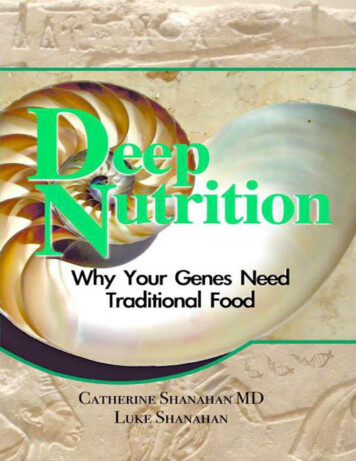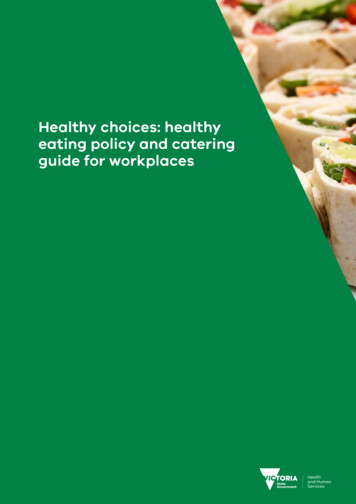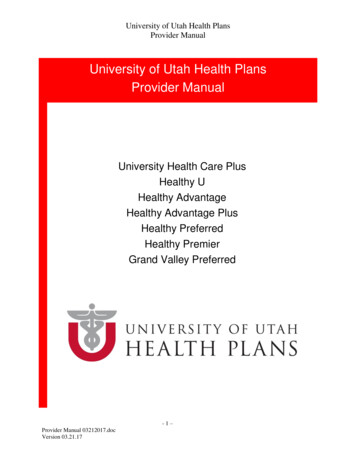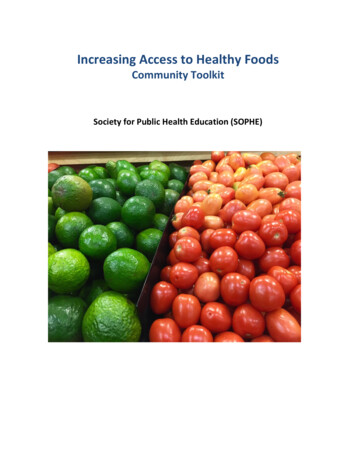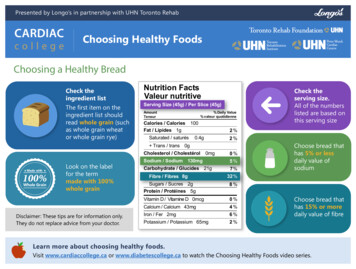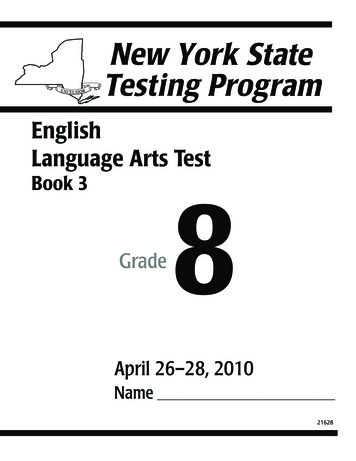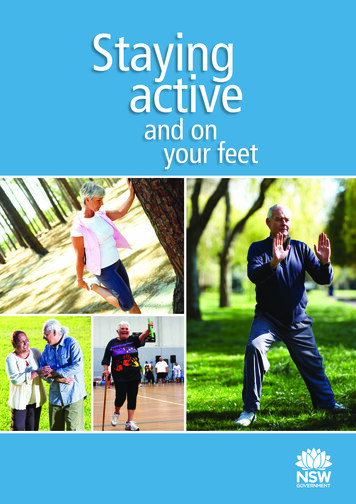
Transcription
Stayingactiveand onyour feet
AcknowledgementsThis booklet has been developed by the Clinical Excellence Commission for the Centre forPopulation Health, NSW Ministry of Health, 2013. The contributions from the NSW Local HealthDistricts are acknowledged with thanks. We would also like acknowledge:Professor Lindy Clemson, Faculty of Health Sciences, University of SydneyProfessor Cathie Sherrington, The George Institute for Global HealthCEC Consumer Advisory Group & Health Service Consumer Focus GroupsThe material in this publication is based in part on material from:Stay on your feet. Your home safety checklist (2004), NSW Ministry of Health Falls can beprevented: A guide to preventing falls in older people (2007), Department of Health and AgeingNSW Health acknowledges the Australian Government Department of Health and Ageingfor providing use of their copyright materials in the production of this document. NSW Healthacknowledges Queensland Health, Queensland Stay On Your Feet Image Library for the useof their copyright images.NSW Health acknowledges the Aboriginal Medical Service Co-Operative for the use of theircopyright image on the cover page. NSW Health acknowledges The George Institute for GlobalHealth for the use of their copyright image on page 8.For further copies of this booklet, contact:Centre for Population Health Resource Distribution UnitTel. 1300 655 957Fax. 1300 550 570Email. popresources@doh.health.nsw.gov.auTo download a copy of this booklet go to www.activeandhealthy.nsw.gov.auNSW MINISTRY OF HEALTH73 Miller StreetNORTH SYDNEY NSW 2060Tel. (02) 9391 9000www.health.nsw.gov.auThis work is copyright. It may be reproduced in whole or in part for study and training purposessubject to the inclusion of an acknowledgement of the source. It may not be reproduced forcommercial usage or sale. Reproduction for purposes other than those indicated above requireswritten permission from the NSW Ministry of Health. NSW Ministry of Health 2013.SHPN (CPH) 180615ISBN 978-1-76000-953-3 (print)ISBN 978-1-76000-952-6 (online)Editorial by RaggAhmed and design by Rock Lily Design & Consulting.The information included in this resource is provided for general information only and is not asubstitute for independent medical advice. Please consult your health care provider if you haveor suspect you have a health problem. Use of the exercises, advice, and information contained inthis resource is at the sole choice and risk of the reader.First edition: August 2013Reprinted: May 2014Revised: April 2016, October 2018
ContentsStaying active . 2Exercise at home. 4Healthy eating. 6Calcium. 6Vitamin D and sunlight. 7Water. 7Your health. 8Mobility and walking aids. 8Eyesight. 9Footwear. 9Continence. 10Your medicines. 12Health & lifestyle checklist. 14If you have a fall . 16Home safety checklist. 18Fall-proof yourself. 20Useful contacts. 21References. 24
Staying activeStaying physically active is the single mostimportant thing we can do to stay fit andindependent.As we grow older we lose muscle strength and senseof balance and this can lead to a fall. The more activewe remain, the better the chance of keeping ourmuscles strong, our joints mobile and maintaininggood balance.Staying active reduces our risk of a fall, whichhelps keep us independent and improves ouroverall health and wellbeing.How much activity is enough? At least 30 minutesa day, 5 days a week, is recommended. Theexercise should be brisk enough to increase yourbreathing and heart rate, although it doesn’thave to be so hard that you can’t talk.Activities to get your heart rate up and helpbuild fitness include: aqua aerobicsStaying physicallyactive is the singlemost important thingwe can do to staywell and independent.2Staying active and on your feet brisk walking golf group exercise classes swimming.To reduce your risk of falling, it’s also important toinclude activities that improve your balance andincrease your strength. Try to include these into yourroutine every day.
Activities which are particularly goodfor balance and strength include: dancing gym sessions group exercise classes home exercises lawn bowlsBy improving yourbalance and strength,you reduce yourrisk of falling andcausing an injuryor breaking a bone. pilates Tai Chi yoga.These types of activity have plenty ofbenefits. They help keep your heartstrong, your blood pressure down, andcontrol your weight. By improving yourbalance and strength, you reduce yourrisk of falling and causing an injury orbreaking a bone. And they keep youactive enough to do the things you wantto do, whether that be getting out of thechair easily or maintaining the garden.Try to mix up the activities — this willexercise different muscles and helps keepyou interested. You don’t have to do it allin one go — being active in 10 -15 minuteslots during the day works just as well.Find a local balance and strengthprogram by visiting the Active & Healthywebsite at:www.activeandhealthy.nsw.gov.auAge is no barrier — research shows thatany exercise, at any age, is worth theeffort. If you are in any doubt aboutexercises, please talk to your doctor.Staying active and on your feet3
Exercise at homeThe following balance and strength exercises are easy to do at home. Make sure you havea chair, benchtop or wall nearby for support when you try them. Once you become moreconfident, you can hold for longer or increase the number of repetitions. Use smoothmovements when performing these exercises and take your time. Stop exercising ifyou experience any unusual pain or discomfort and seek advice from a qualified healthprofessional. You can view video instructions for all of these exercises on the Active andHealthy website www.activeandhealthy.nsw.gov.au1. Heel to toe standing / walking Helps keep balance when you have to walk through a narrow space With fingertips on something solid to help balance, stand heel to toe,bend your knees slightly and keep still for 10 seconds. Vary the exercise with feet close together and one foot halfwayin front of the other. Upgrade the exercise by walking slowly, placing your heel to touch the toeof the other foot.2. Knee raises Helps with climbing stairs and getting in and out of cars and buses With fingertips on something solid to help balance, lift a knee to hip leveland hold it for 5 seconds. Repeat with the other leg. Then repeat 8 times.Staying physicallysinglewalking3. Sideactiveleg raiseis/ thesidewaysmostimportantthing Improvesstabilitywhen you haveto take weight on one leg,and helps you step sideways to avoid trippingwe can do to stay With fingertips on something solid to help balance, stand onwellandtheindependent.one legand raiseother sideways, holding it for 5 seconds. Repeat 8 times. Then do it with the other leg. Extend to walking sideways with slow steps alongside abench or table.4Staying active and on your feet
4. Heel raise Helps with walking and climbing stairs With fingertips on something solid to help balance,lift both heels off the floor and stand on your toes for 3 seconds,then slowly lower your heels to the floor. Repeat 5 times.5. Stepping up a step Improves stability on steps, paths and uneven surfaces Holding onto a rail, go up and down a single step. Repeat 5 times.6. Sit to stand Helps with getting up and down from achair or toilet, and in and out of the car Stand up slowly from a chair, keepingyour knees slightly apart. To make itharder, cross your arms in front of yourchest or hold them out in front of youat shoulder height. Then lower yourself back down into the chair. Repeat 5 times. If this is too strong for your knees, start offusing a chair with armrests to push off from.Staying active and on your feet5
Healthy eatingEating healthy food in a balanced diet is veryimportant to help you get the energy you need,maintain good health and have strong bonesand muscles.We all know what healthy food is — a wide rangeof fruit and vegetables, some protein sources suchas meats, dairy and legumes / lentils, and not toomuch fatty or highly processed food. Drinkingplenty of water is important, too.As we age, our bones are susceptible to becomingfragile and breaking. For them to stay strong,they need: calcium vitamin D.CalciumCalcium is only stored in your bones, althoughit is essential for many different parts of the body,such as muscles and nerves.Many people don’tget enough calciumor vitamin D. Talkto your doctor aboutyour calcium intakeand Vitamin D level.6Staying active and on your feetIf you don’t eat enough calcium, it will be takenfrom your bones to other parts of the body whereit is needed. As we get older, we absorb less andless calcium from our food. This means we actuallyneed to eat more calcium as we get older.People who smoke, who drink a lot of caffeine andsoft drinks, and who eat a lot of meat, absorb lesscalcium from their diet than others.Milk, yoghurt, cheese, salmon, sardines, tahini,figs, almonds and brazil nuts are all good sourcesof calcium.Bread, cereals, fruit and green vegetables suchas broccoli and bok choy also have calcium,although not as much.
You get vitamin D in two ways —from your diet and from sunlight.Vitamin D is only found in certain foods.These are: milkThe following menu is an example ofa typical day’s eating that would helpyou reach the recommended intakeof calcium (1300 mg per day).Breakfast: Toast or muesli plus a tubof low fat yoghurtLunch: Wholemeal sandwich withcheese, chicken and saladDinner: Pasta or rice with tinned salmonor tuna and vegetables such as peas,broccoli and carrotsSnacking on fresh or dried fruit, cheese,and nuts and a glass of milk/soy milkeach day will make up the rest. Calcium enriched breads, juice and milk can begood sources for additional calcium.Vitamin D and sunlightVitamin D is very important for strongbones. Being low in vitamin D canaffect your muscle strength and play apart in causing osteoporosis becausewithout it calcium won’t be fullyabsorbed by your bones. oily fish such as salmon and mackerel eggs.Sunlight is another way of getting vitaminD. Sunlight acts on the skin and convertsit to vitamin D. 6-8 minutes in summerand 13-16 minutes in winter is enough.For more information about theimportance of vitamin D visit:www.osteoporosis.org.au/vitamin-dWaterMany people don’t drink enoughwater. Lack of water can lead todehydration, weakness and dizziness,and is a common cause of older peoplefalling and hurting themselves.Drink at least 6 glasses of fluida day, preferably water.Staying active and on your feet7
Your healthA number of health conditions can affect yourability to move around or make you feel unsteadyon your feet. These conditions include arthritis,osteoporosis, diabetes, heart problems, breathingproblems, depression, Parkinson’s disease anddementia.These conditions may increase the risk of losingyour balance, tripping and falling. Even short ‑termillnesses (such as the flu or other infections) canaffect your stability.Have regular check-ups and talk to your healthprofessional for advice on how these conditionsmight affect you. You can also get advice onactivities you can safely do to regain balance,strength and confidence.Mobility and walking aidsA walking aid may help improve your safetyand mobility.Have regularcheck-ups andask your healthprofessional foradvice on activitiesto improve balanceand strength.8Staying active and on your feetIf you think that this would benefit you, talkto a health professional such as a physiotherapistor occupational therapist. They will be able tosuggest the most suitable aid for you and showyou how to use the aid safely and confidently.If you do use a walking aid at home, you mightneed to rearrange your furniture so that youcan move around easily.
EyesightOur eyes change rapidly as we age,and it becomes more difficult to judgedistances, cope with glare and adjust tosudden changes in light. This can affectyour ability to see the edges of stepsand stairs.Have your eyes checked by anoptometrist or ophthalmologist at leastevery two years, and by your doctor inthe years between.Bifocal, trifocal or multifocal glassesincrease the chances of falling, as thechanges in the lens can make it difficultto judge distances and to see unevenfootpaths and the edges of stepsand stairs.Give your eyes time to adjust to suddenchanges in light, and ensure that youhave good lighting at home andon stairs.Other eye conditions, such as maculardegeneration, glaucoma, cataracts,and diabetic retinopathy, impair vision.They may require you to learn newskills to move around safely.FootwearConsider having a separate pair ofglasses for walking outdoors.If you get new glasses or any treatmentfor your eyes, be especially careful.You will need to allow your eyesighttime to adjust.Safe FootwearHealthy feet and well-fitted footwearhelp reduce your chances of trippingand falling.As we age, our feet can changeshape and lose some feeling andflexibility. This changes the way wewalk and affects balance. See yourdoctor or a podiatrist, if you havepainful or swollen feet.Keep your feet healthy by keepingnails trimmed and getting treatmentfor bunions, corns and calluses.Staying active and on your feet9
ContinenceProblems with incontinence (both urinary andfaecal) may contribute to the risk of a fall byhaving to rush to the toilet. Incontinence maybe due to poor bladder and bowel habits, or theweakening of muscles that support the internalorgans including the bladder and bowel (pelvicfloor muscles).Signs of a healthy bladder and bowel: Urinating between 4-8 times a day, and once(or not at all) during the night Urine that is usually pale yellow – dark yellowor brown urine may indicate that you are notdrinking enough (dehydration) Bladder telling you when it is full, but allowingenough time to get to the toilet without leaking Bowel movements up to three times a day orthree times a week are normalProblems withincontinence maycontribute to the riskof a fall by having torush to the toilet.10Staying active and on your feet Bowel motions should be soft yetwell-formed.
Prevention of incontinence: To prevent urinary and faecal incontinenceit is important that you: Drink plenty of water Eat a high-fibre diet Are physically active Practice good toilet habits Make healthy lifestyle choicesWhat you can do:Seek help from your doctor.Check with your doctor if your medicationsare causing the problem.Your doctor may refer you to a continencespecialist: physiotherapist, nurse or doctor.Cut back on caffeine and alcohol, especiallybefore going to bed at night.Ensure the path to the toilet is free fromclutter, obstacles and slipping hazards.Ensure that there is good lighting to thetoilet. Use night lights for the route to thetoilet at nights.If the toilet is not nearby, place and useurinals or commode chairs close to the bed.Staying active and on your feet11
Your medicinesSome medicines—whether they are prescriptionmedicines or those bought without prescription—can make you dizzy or drowsy. This can predisposeyou to falling over.The medicines that make falls more likely includethose for: anxiety depression sleeping difficulties.People who take four or more medicines a dayare at particularly high risk of falling.TipsPeople who take4 or more medicinesa day are atparticularly highrisk of falling. Make a list of every medicine you take,and take it with you when you go to seea doctor or pharmacist. This list shouldinclude any herbs, tablets or supplementsyou buy from a health food store or fromthe health food section of the supermarket,as well as any medicines you buy froma pharmacy.Talk to your doctor about your current medicationsand whether there are any that could be discontinued.For a list of questions you may like to ask your doctor orpharmacist visit the NPS MedicineWise website:www.nps.org.au12Staying active and on your feet
Ask your doctor to review thislist thoroughly. Doing this every6 months is a good idea if youtake four or more medicines aday. Otherwise, once a yearis enough. If you find it difficult toremember which medicationsyou take and when to take them,ask your pharmacist or doctorabout devices that may help suchas pill boxes or Webster-paks .Ways to improve your chances of agood night’s sleep: get into a good relaxing bedtimeroutine go to bed at about the same timeeach night get up at about the same timeeach day restrict alcohol, caffeine andsmoking, which are all stimulants. If you feel dizzy or find it hard toconcentrate, contact your doctoror pharmacist straight away. If you take anticoagulantmedicines (blood-thinners), youshould always see a doctor if youhave a fall, as you may be at riskof severe injury and bleeding. Avoid sleeping tablets if possible. Only take your own medicinesand don’t use someoneelse’s, even if they are forthe same condition.Webster-paks —Image courtesy of Queensland HealthStaying active and on your feet13
Health & lifestyle checklistIf you answer Yes to most of these questions, then you are doing well.If you answer No or Not always or Not sure to more than one of thequestions, then you may be at risk of a fall. You might like to discuss this checklistduring your next appointment with a health professional.YesStaying activeDo you engage in physical activity (e.g. walking, swimming or groupexercise) for 30 minutes or more, most days of the week?Do you include balance and strength activities such as dancing,Tai Chi, yoga or an exercise session provided by a health professionalor a fitness instructor?Calcium, vitamin D and waterDo you eat 3 healthy meals per day?Do you eat at least 3–4 serves of high calcium foods(milk, yoghurt, cheese, almonds or salmon) per day?Do you spend a little bit of time in the sun?(6–8 minutes, 4–6 times per week, is plenty.)Do you drink 4–6 glasses of water (or other fluids) per day?Getting out and aboutCan you get out of a chair easily?Do you feel steady when walking?’14Staying active and on your feetNotAlwaysNo
YesNotAlwaysNoYesNotSureNoManaging health conditionsDoes your current health allow you to confidently manage all yournormal activities?Can you stand up and move around without feeling light-headed,dizzy or faint?Do you have good control of your bladder and bowel so that you canget to the toilet without rushing?EyesightHave you had your eyes examined in the last 12 months?FeetHave you had your feet checked for corns, bunions or other footproblems that may cause pain and may affect your balance?MedicinesHave you had your medications reviewed by your doctor in thelast 12 months?History of fallingHave you stayed on your feet (been free of falls) for at least thelast 6 months?Staying active and on your feet15
If you have a fall Knowing what to do if you do have a fall canhelp you feel more confident.It is important to have an emergency plan: know who to call for help — you could keepa list of the phone numbers of family orfriends near the phone, or program theminto the phone for one-touch dialling have a phone within reach on a low table,in case it is hard to get up protect yourself by considering whether youwould want a device that raises an alarm incase of emergency let trusted family and friends know how toget into your house if you can’t let them in.The following technique for getting up if youdo fall is worth knowing. Firstly try not to panicand take your time. Make sure you are not injuredbefore trying to move. If you have a personalalarm or phone close by use it to call for help.It is important to havean emergency plan.1. Bend your knees and roll onto your side16Staying active and on your feet
2. Crawl or drag yourself to a chair3. Face the chair and get up onyour knees4. Bring one knee forward and putthat foot on the floor, then use thechair to push up with your armsuntil you are upright enoughto pivot your bottom around to sit5. Rest for a while before standing upIf you can’t bend your knees very well, slide along on your bottom then lift yourhips onto something higher, such as stairs. Then you can pull yourself upright again.You might even like to practise these techniques so that if you ever need to get upfrom the floor, you will feel more confident.You should see your doctor after a fall if: you are taking anticoagulant medicines you bump your head and feel drowsy or unwell afterwards you have a pain that concerns you you are worried about being unsteady, or falling again.Staying active and on your feet17
Home safety checklistAbout half of all falls occur in and around the home. You can reduce your chancesof having a fall at home by making sure that you have followed some basic homesafety guidelines.This checklist will help you identify aspects of your home that might increase yourrisk of a fall. Walk around each room and check that there is nothing that mightpose a risk. For small safety improvements, see if a family member, friend or localhandyperson can help you fix the problem. A health professional can also arrangefor an occupational therapist to perform a home safety assessment and arrangefor installation of home modifications.The Australian Government’s My Aged Care phone line and website can help youto access services and find information. You may be eligible for home modificationsand equipment like walking aids. www.myagedcare.gov.au or 1800 200 422.YesEntrance and hallwayLight switches easy to reach and near each doorway or hallwayDoorbell easy to hear from other roomsRugs or mats with slip-resistant backingStairs and stepsLight switch at both the top and bottom of stairwaysStairs and steps well litStaying physicallyactiveis markedthe singleEdges ofsteps clearlyNon-skidtreads orpaint used on thethingedges of each stepmostimportantKitchenwe can do to stayRegularlyused itemseasy reach without climbing or bendingwellandwithinindependent.Carpets or runners securely fixedSturdy handrailGood lighting over benchtops and other work areasGood ventilation to reduce the risk of glasses foggingFloor surfaces slip resistantSpills cleaned up straight awaySturdy low step stool with handrail if need to use higher shelves18Staying active and on your feetNo
YesNoLounge / Dining roomGood light (natural or artificial)Carpets and mats lie flat without wrinkles, curled or frayed edgesFurniture arranged so that it is easy to walk aroundCords and cables safely away from walkwaysLounge chair easy to get out ofTelephone within easy reachBedroomBed easy to get in and out ofBedside light easy to switch on when in bedConsider nights lights or motion sensor lightsTelephone within easy reach when in bedBedside table for drink, books, glassesBed coverings clear of the floorCords and cables safely away from walkwaysWalking aid (if required) within easy reach of the bedBathroom and toiletSlip-resistant mats on the floorShower easy to access without stepping over a raised edge or hobSecure handrail in shower or on wall next to bath to avoid holding on to tapsor towel rail to get outSoap and shampoo within easy reach without bendingTowel rail within easy reach from bath or showerHandrail next to toiletOutside the homePaths and entrances well lit at nightPaths in good repairSteps with a sturdy, easy-to-grip handrailEdges of steps clearly marked and with slip-resistant stripStepladder short and sturdy with slip-resistant feetClothes line easy to access and reachGarden kept free of trip hazards, such as tools and hosesGarage / shed uncluttered and floors free of oil and greaseFootpaths and public areas in good repairStaying active and on your feet19
Fall-proof yourselfQ. Are you active and on your feet?Being physically active is important to stay well,independent and to do everyday tasks.Q. Is your vision changing?As we grow older our vision changes. We do notsee as clearly, are less able to judge distance anddepth, and adjust to sudden changes in light.Q. Are you taking medications?Some medicines can increase your risk of falls,especially those taken for anxiety, depressionor difficulty sleeping. Medication may makeyou feel drowsy, unsteady, dizzy or confused.Q. Are your feet sore?Feet can change shape and lose some feeling.Painful and swollen feet make it difficult toStaying physicallywalk and some shoes or slippers may causeyou to activestumbleisorthetrip.singlemost important thingdo tostay D?Q. Are weyou candeficientin Vitaminwell andin independent.Being deficientVitamin D can affect yourbone and muscle strength as this vitaminhelps our bodies to absorb calcium from food.20Staying active and on your feetDo balance andstrength exercisesHave your eyes checkedTalk to your doctorHave your feet checkedand wear comfortable,firm-fitting, flat shoesTalk to your doctorVisit www.osteoporosis.org.au
Useful contactsAUSTRALIANGOVERNMENTEat for Healtheatforhealth.gov.auHealthdirect Australiawww.healthdirect.gov.auPh: 1800 022 222Free 24-hour telephone healthadvice service line staffed byregistered nurses to provide experthealth advice.My Aged Carehttp://www.myagedcare.gov.au/Ph: 1800 200 422If you need an interpreter ring131 450 and ask for 1800 200 422Veterans Affairswww.dva.gov.auPh: 13 32 54 or 1800 555 254Offers support and services forpeople eligible for assistance.NSW GOVERNMENTAboriginal Home Care ServicePh: 1300 797 606Active & Healthy websitehttp://www.activeandhealthy.nsw.gov.au/This website provides informationabout where to find a strength andbalance program in your local areaand information about remainingindependent.Agency for Clinical tion on aged health, painmanagement, chronic disease andmusculoskeletal issues.CEC Falls Prevention alls-preventionEmail: CEC-FALLS@health.nsw.gov.auFalls prevention informationincluding flyers for patients/familiesand carers.Department of Social mmePh: 1800 836 799The Australian GovernmentDepartment of Social Servicesadminister the CommonwealthHome Support Programme. Theprogramme provides entry-levelhome support for older peoplewho need assistance to keep livingindependently.Family & Community ServicesOffice for Ageingwww.ageing.nsw.gov.auGet Healthy Informationand Coaching ServiceHome Care ServiceHunter/Central Coastand rural regionsPh: 1300 881 144Home Care ServiceSydney Metropolitan AreaPh: 1800 350 792Home ModificationInformation Clearinghousewww.homemods.infoPh: 1800 305 486Provides a range of consumerfactsheets and information on homemaintenance and modifications.Make Healthy Normalhttps://www.makehealthynormal.nsw.gov.au/Ph: 02 9391 9000NSW Falls Prevention Networkhttp://fallsnetwork.neura.edu.auInformation on healthy ageing forconsumers and health professionals.NSW Healthwww.health.nsw.gov.auPh: 02 9391 9000Provides information and links topublic health services within NSW,and access to health professionalssuch as community nurses, dentists,dieticians, doctors, occupationaltherapists, optometrists,pharmacists, physiotherapists,podiatrists and psychologists etc.NSW Seniors Cardwww.seniorscard.nsw.gov.auPh: 13 77 88Transport NSWwww.transportnsw.infoPh: 131 500Information and links to ticketsand Opal card and concessions forseniors.www.gethealthynsw.com.auPh: 1300 806 258Staying active and on your feet21
Useful contactsCOMMUNITYORGANISATIONSArthritis & Osteoporosis NSWContinence Foundationof Australiawww.continence.org.auPh: 1800 330 066www.arthritisnsw.org.auPh: 1800 011 041 (free call in NSW)Continence Foundationof Australia in NSW IncAssistive Technology AustraliaPh: 02 8741 5699www.ilcaustralia.org.auPh: 1300 452 679 (Infoline)Ph: 02 9912 5800 (Reception)COTA (Council on the Ageing)NSWAustralian Academy of Tai Chi andQigongwww.livingchi.com.auPh:02 9797 9355Australian Associationof Social Workerswww.aasw.asn.auPh: 02 9518 4944Australian : 02 8748 1555Australasian Podiatry Councilwww.apodc.com.auPh: 03 9416 3111Australian Psychological Societywww.psychology.org.auPh: 1800 333 497www.cotansw.com.au 9am to 3pmPh: 02 9286 3860 or 1800 449 102Dementia Australiawww.dementia.org.auPh: 1800 100 500 (national dementiahelpline)Dementia Australia NSWMS Australiahttp://www.msaustralia.org.au/Ph: 1300 010 158Heart Foundationwww.heartfoundation.org.auPh: 13 11 12Neuroscience Research Australia,Falls, Balance and Injury -balanceInformation and research on falls andbalanceNPS MedicineWiseDiabetes NSWwww.nps.org.auPh: 1300 633 424 (Medicines Line)9am to 5pmwww.diabetesnsw.com.auPh: 1300 342 238Dietitians Associationof Australiawww.daa.asn.auPh: 02 61
As we grow older we lose muscle strength and sense . of balance and this can lead to a fall. The more active we remain, the better the chance of keeping our muscles strong, our joints mobile and maintaining good balance. Staying active reduces our risk of a fall, which helps keep us independent and improves our . overall health and wellbeing.



